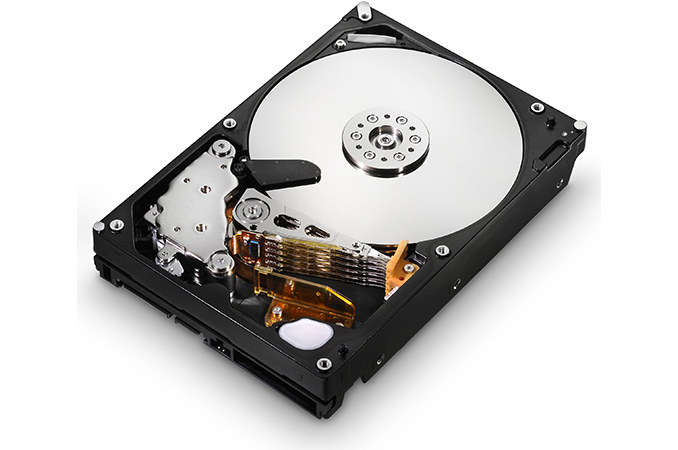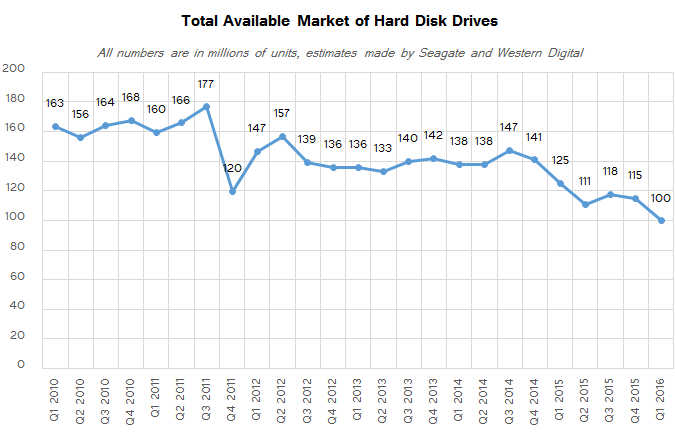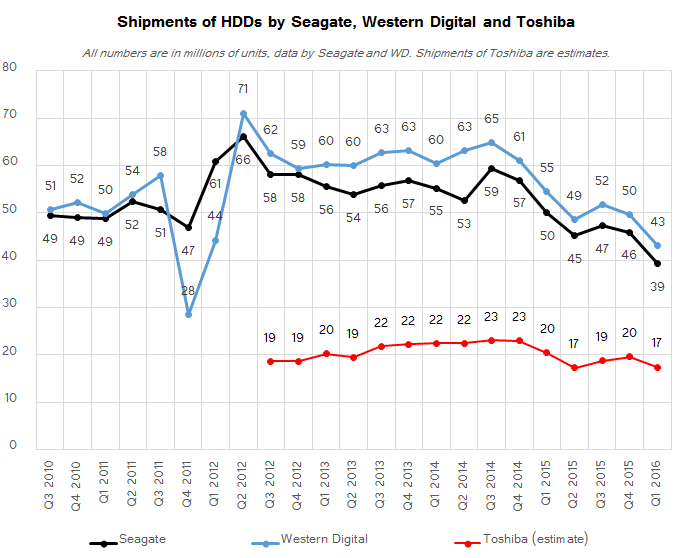Market Views: HDD Shipments Down 20% in Q1 2016, Hit Multi-Year Low
by Anton Shilov on May 12, 2016 8:00 AM EST
Leading industry watchers like IDC and Gartner early this year predicted that the first quarter of 2016 would not be good for the PC industry and various companies agreed with that. The reasons for the declines are well known: global economic issues, the slowdown in China, the strong U.S. dollar as well as competition from smartphones and other devices. As sales of PCs were not strong as predicted, this negatively affected the hard drive market.
According to Gartner, PC shipments worldwide totaled 64.8 million units in the first quarter of 2016, a decrease of 9.6% from Q1 2015. The company notes that this was the first time since 2007 that shipment volume fell below 65 million units. Analysts from IDC are even more pessimistic because based on their findings, shipments of PCs in the first quarter totaled 60.6 million units, a year-over-year (YoY) drop of 11.5%. As we noted in our previous coverage of the HDD market earlier this year, the decline of HDD shipments in 2015 significantly outpaced the regress of the PC market. As it appears, the same happened in the first quarter of 2016 as the total available market of hard drives dropped to a new multi-year low.
Shipments of HDDs Total 99.8 Million Units in Q1 2016
Seagate, Toshiba and Western Digital, the three remaining producers of HDDs, shipped a total of 99.8 million hard drives in Q1 2016, or 20% less than in the same period a year ago according to their estimates (see counting methodology below). According to estimates from Nidec, the company that sells the majority of small precision motors for HDDs (over 80% of them, based on its own estimates), the industry sold 98 million hard drives in Q1, but it is worth noting that Nidec is typically very conservative. In the same quarter of last year, Seagate, Toshiba and Western Digital sold 125 million HDDs, whereas just six years ago the industry shipped 163 million units. In fact, even in Q1 2006, sales of HDDs totaled 101.7 million units, according to iSuppli (via EDN), which means that we might be talking about a 10-year low in hard drives shipments.
Sales of PCs in general (and hard drives in particular) are seasonally not strong in the first quarter of the year, which is why it is not surprising that they declined to around 100 million units from 115 million units in Q4 2015. What is alarming is that despite this seasonal change, Q1 2015 shipments of HDDs were higher than sales of hard drives in each of the remaining quarters last year. If this year follows the same negative pattern, then HDD shipments will be below 100 million units in the second quarter and will remain below that level in the second half of the year. Western Digital estimates that total available market (TAM) of HDDs will decline to 95 million units in the second quarter, which means a decline of around 15% from the same period last year. A moderately good news is that Western Digital seems to be optimistic about the second half and believes that HDD TAM will remain above 400 million units mark in 2016 (compared to 456 million units in 2015), which means that shipments of hard drives will grow in calendar Q3 and calendar Q4. IDC has asserted that inventory reductions, cautious buying and other additional elements of the equation that directly affected makers of components in the recent quarters are wrapping up, Western Digital’s optimism could well be justified.












116 Comments
View All Comments
Gothmoth - Thursday, May 12, 2016 - link
HDD´s drop dead like flies... no wonder nobodys want´s to buy that crap.seagate is replacing my 3 month old 4TB drive with a FACTORY REPAIRED drive.
i did not pay for a second hand drive!!!
WD is not much better.
seagate cheats their customers with their crappy warranty.
jwcalla - Thursday, May 12, 2016 - link
I agree. It's one of the reasons I'm hesitant to buy any. Most of them are complete junk.SirGCal - Friday, May 13, 2016 - link
Test your drives before use. Especially Seagates. Their build practices frighten me. I have 8 4TB drives, and went through 22 drives before I got 8 that passed the tests... THAT is scary. But they've been running since release without further issues. I hear they are far better now but I still test each one before using it.jbrizz - Sunday, May 15, 2016 - link
You can probably thank weak consumer protection laws for that. In AU and NZ (and probably UK and other parts of Europe) they don't do that because it's not legal.svan1971 - Thursday, May 12, 2016 - link
The price has not gone down though...sonicmerlin - Thursday, May 12, 2016 - link
That's because the $/GB has barely budged since what it was at before the 2011 flood. I remember routinely seeing 3 TB internal HDDs going on sale for $80 before the flood.Then the HDD vendors all merged and jacked up prices while massively slowing down aerial density innovations.
SirGCal - Friday, May 13, 2016 - link
Hu? They are up to 10TB drives now in test cases and 8TB regularly purchasable... It's only 2016. Plus the cost of components has changed. I'd consider the 2011 pre-flood an all time low, rather amazing prices then a norm to aim for... Still I never saw a 3TB drive I'd buy, let alone one for that price.Burns101 - Thursday, May 12, 2016 - link
HDDs are only good for porn and movies!iwod - Thursday, May 12, 2016 - link
You can now get a very decent Plextor M7V ( TLC Based ) or SanDisk SSD Plus ( MLC Based ), both with decent Controller and Firmware support for less then $40 with 128GB.I expect the price to stay put, in 2017 once all the Fab from China and New Fab from Samsung are up, we will likely see 256GB SSD going for $40 in 2018. That should be the point where most people are fine with SSD in terms of capacity.
stevenrix - Friday, May 13, 2016 - link
The hard-drive market going down sounds like a predictive failure from their own technical jargon.It was worth mentioning that the price per gig on the hard-drives won't go down, which means that at some point in time, when the prices of the hard-drive will go up according to their bigger capacity (10 Tb, 12 Tb ...etc) and the price of the SSDs going down, then it will make it easier to switch to SSDs. In other words their strategy won't resist that much in time. Also if prices since the flood in Thailand have not much fluctuated on the hard-drives makers, the cost on the consumer went from 1 to 3 for the same hard-drive capacity. A few days before the flood I had bought around 20 Tb of drives for a few hundreds of dollars, and i have never seen those prices going back to those prices and it probably will never go back to that trend.
At a consumer level, I am willing to upgrade to 8Tb drives, but those prices are too expensive. I am pretty sure that many consumers are waiting to upgrade to bigger drives and are waiting to see the prices getting slashed. Worse case scenario I will keep buying 4 Tb drives. It is the enterprise market that help the hard-drives makers to survive, especially in the NAS enterprise market (a SAS 6 15K drive costs so much money). Maybe they should not cut production, but help to replace failed hard-drives with newer hard-drives instead of refurbished drives that will fail again in a few weeks/months to raise customer's satisfaction, because customer's satisfaction dropped to low levels a few years ago. Please make the customer happy first and they'll start buying again hard-drives. Thanks ;)